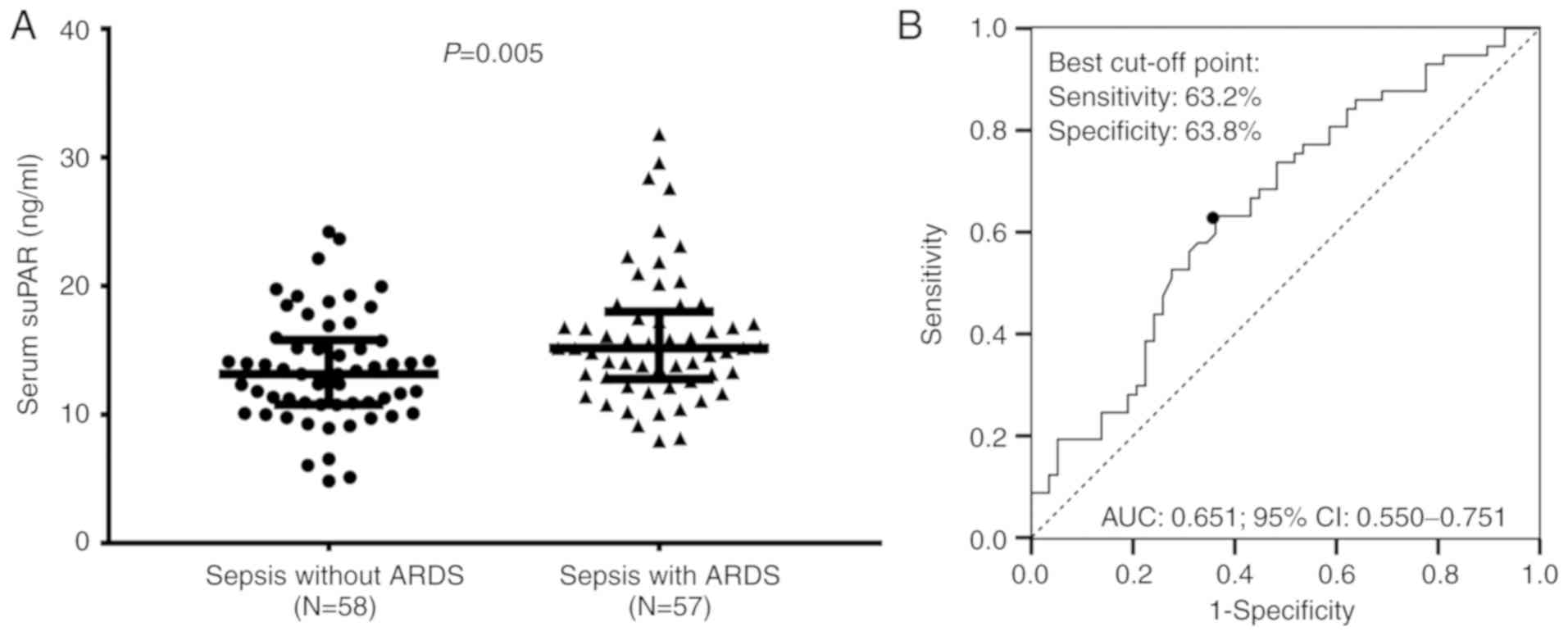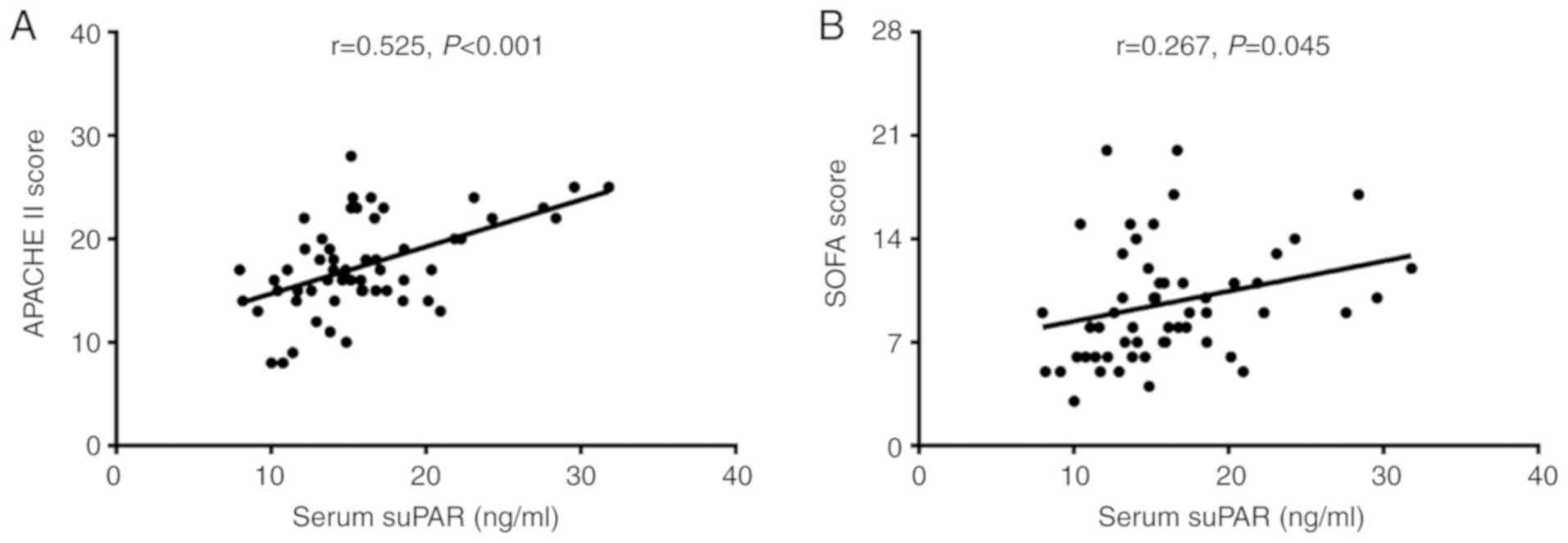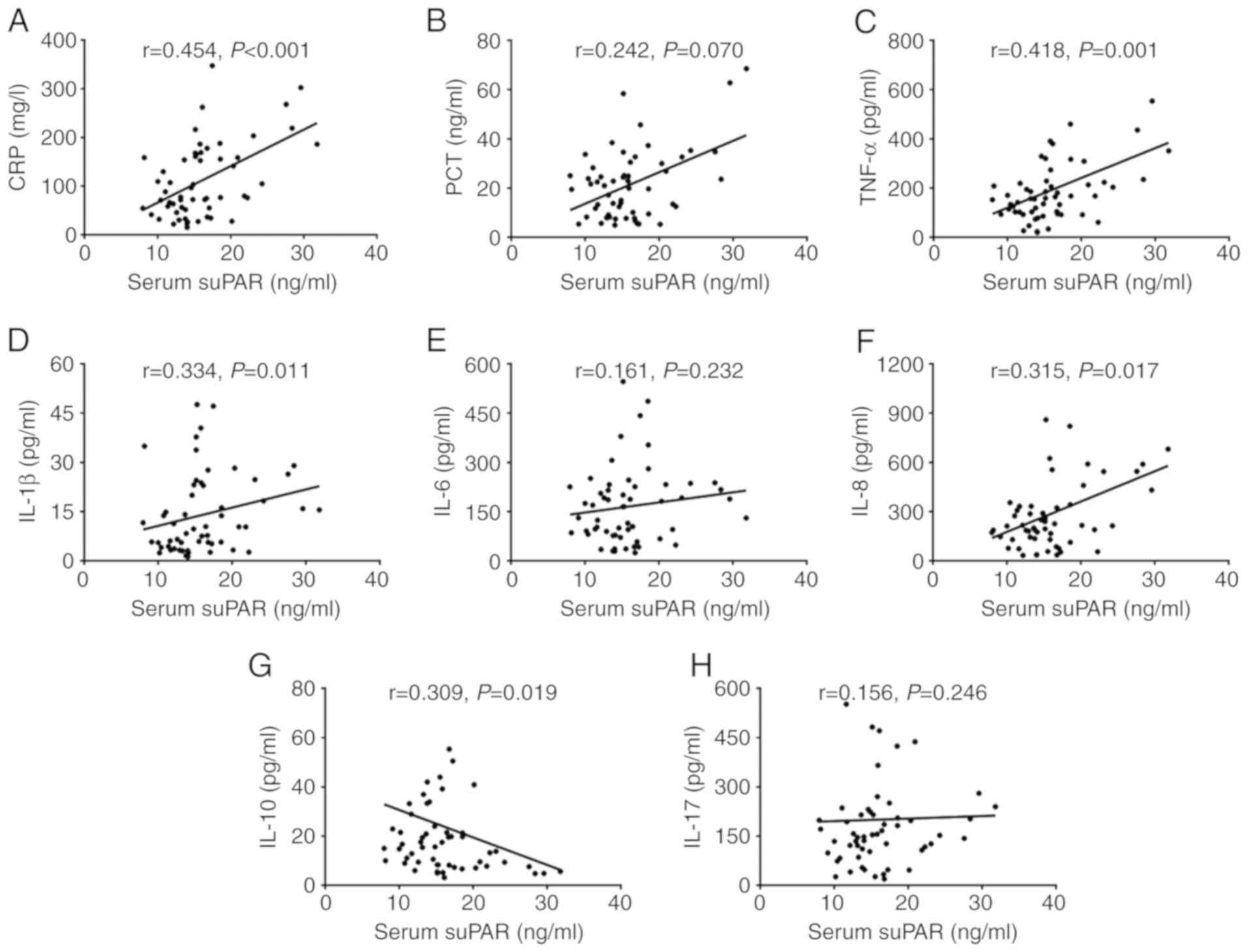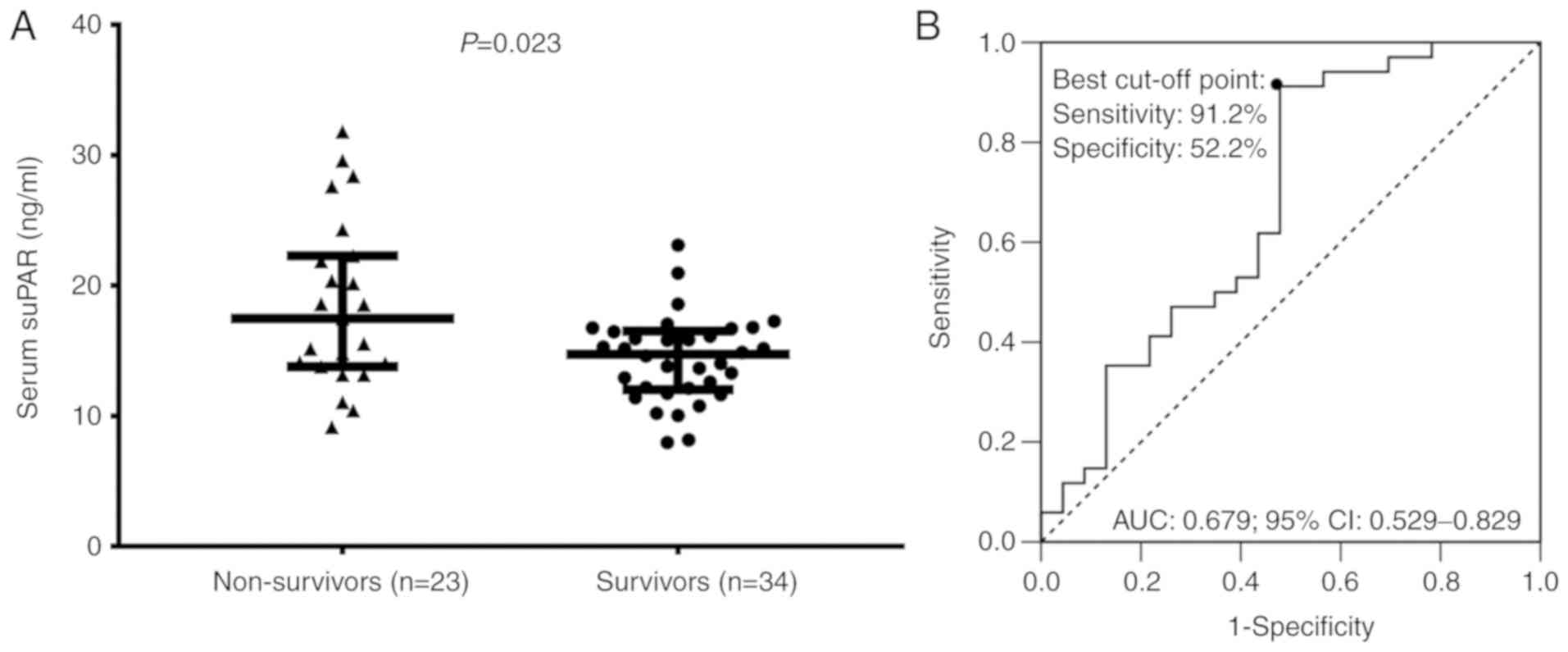|
1
|
Deutschman CS and Tracey KJ: Sepsis:
Current dogma and new perspectives. Immunity. 40:463–475. 2014.
View Article : Google Scholar : PubMed/NCBI
|
|
2
|
Kempker JA and Martin GS: The changing
epidemiology and definitions of sepsis. Clin Chest Med. 37:165–179.
2016. View Article : Google Scholar : PubMed/NCBI
|
|
3
|
Fein AM and Calalang-Colucci MG: Acute
lung injury and acute respiratory distress syndrome in sepsis and
septic shock. Crit Care Clin. 16:289–317. 2000. View Article : Google Scholar : PubMed/NCBI
|
|
4
|
Sheu CC, Gong MN, Zhai R, Chen F, Bajwa
EK, Clardy PF, Gallagher DC, Thompson BT and Christiani DC:
Clinical characteristics and outcomes of sepsis-related vs
non-sepsis-related ARDS. Chest. 138:559–567. 2010. View Article : Google Scholar : PubMed/NCBI
|
|
5
|
Wu SQ, Liang W, Wang GL, Li LY, Wang DL
and Chen C: Polymorphisms of the IL-18 promoter and bronchial
asthma. Mol Med Rep. 6:1385–1388. 2012. View Article : Google Scholar : PubMed/NCBI
|
|
6
|
Grzesk E, Koltan S, Debski R, Wysocki M,
Gruszka M, Kubicka M, Koltan A, Grzesk G, Manysiak S and
Odrowaz-Sypniewska G: Concentrations of IL-15, IL-18, IFN-γ and
activity of CD4+, CD8+ and NK cells at
admission in children with viral bronchiolitis. Exp Ther Med.
1:873–877. 2010. View Article : Google Scholar : PubMed/NCBI
|
|
7
|
Thuno M, Macho B and Eugen-Olsen J: suPAR:
The molecular crystal ball. Dis Markers. 27:157–172. 2009.
View Article : Google Scholar : PubMed/NCBI
|
|
8
|
Mekonnen G, Corban MT, Hung OY, Eshtehardi
P, Eapen DJ, Al-Kassem H, Rasoul-Arzrumly E, Gogas BD, McDaniel MC,
Pielak T, et al: Plasma soluble urokinase-type plasminogen
activator receptor level is independently associated with coronary
microvascular function in patients with non-obstructive coronary
artery disease. Atherosclerosis. 239:55–60. 2015. View Article : Google Scholar : PubMed/NCBI
|
|
9
|
Tzanakaki G, Paparoupa M, Kyprianou M,
Barbouni A, Eugen-Olsen J and Kourea-Kremastinou J: Elevated
soluble urokinase receptor values in CSF, age and bacterial
meningitis infection are independent and additive risk factors of
fatal outcome. Eur J Clin Microbiol Infect Dis. 31:1157–1162. 2012.
View Article : Google Scholar : PubMed/NCBI
|
|
10
|
Wittenhagen P, Kronborg G, Weis N, Nielsen
H, Obel N, Pedersen SS and Eugen-Olsen J: The plasma level of
soluble urokinase receptor is elevated in patients with
Streptococcus pneumoniae bacteraemia and predicts mortality. Clin
Microbiol Infect. 10:409–415. 2004. View Article : Google Scholar : PubMed/NCBI
|
|
11
|
Bastarache JA, Ware LB and Bernard GR: The
role of the coagulation cascade in the continuum of sepsis and
acute lung injury and acute respiratory distress syndrome. Semin
Respir Crit Care Med. 27:365–376. 2006. View Article : Google Scholar : PubMed/NCBI
|
|
12
|
Koch A, Voigt S, Kruschinski C, Sanson E,
Dückers H, Horn A, Yagmur E, Zimmermann H, Trautwein C and Tacke F:
Circulating soluble urokinase plasminogen activator receptor is
stably elevated during the first week of treatment in the intensive
care unit and predicts mortality in critically ill patients. Crit
Care. 15:R632011. View
Article : Google Scholar : PubMed/NCBI
|
|
13
|
Casagranda I, Vendramin C, Callegari T,
Vidali M, Calabresi A, Ferrandu G, Cervellin G, Cavazza M, Lippi G,
Zanotti I, et al: Usefulness of suPAR in the risk stratification of
patients with sepsis admitted to the emergency department. Intern
Emerg Med. 10:725–730. 2015. View Article : Google Scholar : PubMed/NCBI
|
|
14
|
Geboers DG, de Beer FM, Tuip-de Boer AM,
van der Poll T, Horn J, Cremer OL, Bonten MJ, Ong DS, Schultz MJ
and Bos LD: Plasma suPAR as a prognostic biological marker for ICU
mortality in ARDS patients. Intensive Care Med. 41:1281–1290. 2015.
View Article : Google Scholar : PubMed/NCBI
|
|
15
|
Levy MM, Fink MP, Marshall JC, Abraham E,
Angus D, Cook D, Cohen J, Opal SM, Vincent JL and Ramsay G;
International Sepsis Definitions Conference, : 2001
SCCM/ESICM/ACCP/ATS/SIS international sepsis definitions
conference. Intensive Care Med. 29:530–538. 2003. View Article : Google Scholar : PubMed/NCBI
|
|
16
|
ARDS Definition Task Force, ; Ranieri VM,
Rubenfeld GD, Thompson BT, Ferguson ND, Caldwell E, Fan E,
Camporota L and Slutsky AS: Acute respiratory distress syndrome:
The Berlin Definition. JAMA. 307:2526–2533. 2012.PubMed/NCBI
|
|
17
|
Vincent JL, Moreno R, Takala J, Willatts
S, De Mendonca A, Bruining H, Reinhart CK, Suter PM and Thijs LG:
The SOFA (Sepsis-related Organ Failure Assessment) score to
describe organ dysfunction/failure. On behalf of the Working Group
on Sepsis-Related Problems of the European Society of Intensive
Care Medicine. Intensive Care Med. 22:707–710. 1996. View Article : Google Scholar : PubMed/NCBI
|
|
18
|
Knaus WA, Zimmerman JE, Wagner DP, Draper
EA and Lawrence DE: APACHE-acute physiology and chronic health
evaluation: A physiologically based classification system. Crit
Care Med. 9:591–597. 1981. View Article : Google Scholar : PubMed/NCBI
|
|
19
|
Eugen-Olsen J, Gustafson P, Sidenius N,
Fischer TK, Parner J, Aaby P, Gomes VF and Lisse I: The serum level
of soluble urokinase receptor is elevated in tuberculosis patients
and predicts mortality during treatment: A community study from
Guinea-Bissau. Int J Tuberc Lung Dis. 6:686–692. 2002.PubMed/NCBI
|
|
20
|
Kofoed K, Eugen-Olsen J, Petersen J,
Larsen K and Andersen O: Predicting mortality in patients with
systemic inflammatory response syndrome: An evaluation of two
prognostic models, two soluble receptors, and a macrophage
migration inhibitory factor. Eur J Clin Microbiol Infect Dis.
27:375–383. 2008. View Article : Google Scholar : PubMed/NCBI
|
|
21
|
Ostrowski SR, Ullum H, Goka BQ,
Høyer-Hansen G, Obeng-Adjei G, Pedersen BK, Akanmori BD and
Kurtzhals JA: Plasma concentrations of soluble urokinase-type
plasminogen activator receptor are increased in patients with
malaria and are associated with a poor clinical or a fatal outcome.
J Infect Dis. 191:1331–1341. 2005. View
Article : Google Scholar : PubMed/NCBI
|
|
22
|
Pliyev BK: Activated human neutrophils
rapidly release the chemotactically active D2D3 form of the
urokinase-type plasminogen activator receptor (uPAR/CD87). Mol Cell
Biochem. 321:111–122. 2009. View Article : Google Scholar : PubMed/NCBI
|
|
23
|
Sidenius N, Sier CF, Ullum H, Pedersen BK,
Lepri AC, Blasi F and Eugen-Olsen J: Serum level of soluble
urokinase-type plasminogen activator receptor is a strong and
independent predictor of survival in human immunodeficiency virus
infection. Blood. 96:4091–4095. 2000.PubMed/NCBI
|
|
24
|
Ostergaard C, Benfield T, Lundgren JD and
Eugen-Olsen J: Soluble urokinase receptor is elevated in
cerebrospinal fluid from patients with purulent meningitis and is
associated with fatal outcome. Scand J Infect Dis. 36:14–19. 2004.
View Article : Google Scholar : PubMed/NCBI
|
|
25
|
Mondino A and Blasi F: uPA and uPAR in
fibrinolysis, immunity and pathology. Trends Immunol. 25:450–455.
2004. View Article : Google Scholar : PubMed/NCBI
|
|
26
|
Rijneveld AW, Levi M, Florquin S, Speelman
P, Carmeliet P and van Der Poll T: Urokinase receptor is necessary
for adequate host defense against pneumococcal pneumonia. J
Immunol. 168:3507–3511. 2002. View Article : Google Scholar : PubMed/NCBI
|
|
27
|
Park YJ, Liu G, Tsuruta Y, Lorne E and
Abraham E: Participation of the urokinase receptor in neutrophil
efferocytosis. Blood. 114:860–870. 2009. View Article : Google Scholar : PubMed/NCBI
|
|
28
|
Wiersinga WJ, Kager LM, Hovius JW, van der
Windt GJ, de Vos AF, Meijers JC, Roelofs JJ, Dondorp A, Levi M, Day
NP, et al: Urokinase receptor is necessary for bacterial defense
against pneumonia-derived septic melioidosis by facilitating
phagocytosis. J Immunol. 184:3079–3086. 2010. View Article : Google Scholar : PubMed/NCBI
|
|
29
|
Slot O, Brunner N, Locht H, Oxholm P and
Stephens RW: Soluble urokinase plasminogen activator receptor in
plasma of patients with inflammatory rheumatic disorders: Increased
concentrations in rheumatoid arthritis. Ann Rheum Dis. 58:488–492.
1999. View Article : Google Scholar : PubMed/NCBI
|
|
30
|
Pliyev BK and Menshikov MY: Release of the
soluble urokinase-type plasminogen activator receptor (suPAR) by
activated neutrophils in rheumatoid arthritis. Inflammation.
33:1–9. 2010. View Article : Google Scholar : PubMed/NCBI
|
|
31
|
Garcia-Monco JC, Coleman JL and Benach JL:
Soluble urokinase receptor (uPAR, CD 87) is present in serum and
cerebrospinal fluid in patients with neurologic diseases. J
Neuroimmunol. 129:216–223. 2002. View Article : Google Scholar : PubMed/NCBI
|
|
32
|
Yilmaz G, Mentese A, Kaya S, Uzun A,
Karahan SC and Koksal I: The diagnostic and prognostic significance
of soluble urokinase plasminogen activator receptor in
Crimean-Congo hemorrhagic fever. J Clin Virol. 50:209–211. 2011.
View Article : Google Scholar : PubMed/NCBI
|
|
33
|
Backes Y, van der Sluijs KF, Tuip de Boer
AM, Hofstra JJ, Vlaar AP, Determann RM, Knape P, Mackie DP and
Schultz MJ: Soluble urokinase-type plasminogen activator receptor
levels in patients with burn injuries and inhalation trauma
requiring mechanical ventilation: An observational cohort study.
Crit Care. 15:R2702011. View
Article : Google Scholar : PubMed/NCBI
|
|
34
|
Wang H, Yang T, Li D, Wu Y, Zhang X, Pang
C, Zhang J, Ying B, Wang T and Wen F: Elevated circulating PAI-1
levels are related to lung function decline, systemic inflammation,
and small airway obstruction in chronic obstructive pulmonary
disease. Int J Chron Obstruct Pulmon Dis. 11:2369–2376. 2016.
View Article : Google Scholar : PubMed/NCBI
|
|
35
|
Portelli MA, Moseley C, Stewart CE, Postma
DS, Howarth P, Warner JA, Holloway JW, Koppelman GH, Brightling C
and Sayers I: Airway and peripheral urokinase plasminogen activator
receptor is elevated in asthma and identifies a severe, nonatopic
subset of patients. Allergy. 72:473–482. 2017. View Article : Google Scholar : PubMed/NCBI
|
|
36
|
Hamie L, Daoud G, Nemer G, Nammour T, El
Chediak A, Uthman IW, Kibbi AG, Eid A and Kurban M: SuPAR, an
emerging biomarker in kidney and inflammatory diseases. Postgrad
Med J. 94:517–524. 2018. View Article : Google Scholar : PubMed/NCBI
|
|
37
|
Pehlivanlar-Kucuk M, Kucuk AO, Ozturk CE,
Er MC and Ulger F: The association between serum uric acid level
and prognosis in critically Ill patients, uric acid as a prognosis
predictor. Clin Lab. 64:1491–1500. 2018. View Article : Google Scholar : PubMed/NCBI
|
|
38
|
Donadello K, Scolletta S, Covajes C and
Vincent JL: suPAR as a prognostic biomarker in sepsis. BMC Med.
10:22012. View Article : Google Scholar : PubMed/NCBI
|


















